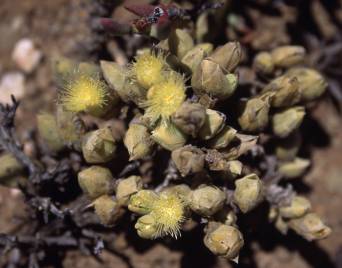
Sceletium tortuosum (Kanna)
Sceletium tortuosum is one of the oldest mesembs known to the western world. It became known to the early colonizers of the Cape in the 17th century and has been cultivated in England since 1732.

It was first described and given a Latin binomial by Carl von Linnaeus, in 1753. The Khoisan people of South Africa, who use the plant in folk medicine, introduced this mood elevating plant to the western world. In recent years, preparations from Sceletium tortuosum are commercialized as anti-depressants and to reduce anxiety. Although the plants are grown commercially on a large scale there is tremendous conservation pressure on wild harvesting of Sceletium species.
Description
Plants are climbing or creeping. The slender branches become thick and only slightly woody with age. Water cells are conspicuous on the leaves that have recurved tips and 3 to 5 major veins. The flowers are very shortly pedicellate (almost sessile) and of medium size (20 to 30 mm diameter). Petals are white to pale yellow, pale salmon or pale pink. The calyx has four or five sepals. Fruit are 10 to 15 mm in diameter and open when wet (hygrochastic). The species is readily distinguishable by the imbricate leaves with incurved tips.

Conservation Status
The species is considered as not threatened and is assessed as Least Concern (LC) on the Red List of South African plants.
Distribution and habitat
It ranges from Namaqualand to Montagu through to Aberdeen and commonly occurs in quartz patches and is usually found growing under shrubs in partial shade.
Derivation of name and historical aspects
The generic name Sceletium is derived from the Latin sceletus, referring to the prominent leaf veins that persist as the skeleton-like structure of the dry leaves. The specific name tortuosum means 'twisted' or 'tortuous'.
The genus contains 8 species and is classified in the mostly weedy subfamily Mesembryanthemoideae. The genus is easily recognized by the persistent dry leaves that become skeletonized. In dry periods, these dry leaves enclose the young leaves protecting them from harsh environmental conditions. The Afrikaans common name kougoed means 'something to chew'.
Ecology
The plants are insect pollinated. Seed dispersal occurs during rain events by means of hygrochastic fruit capsules that open when wet allowing seed to escape.
Uses
Sceletium tortuosum contains mesembrine and the related alkaloids mesembranol and mesembranone. Mesembrine is known for its effects on the central nervous system. The compounds also act as serotonin-uptake inhibitors, and in specified doses act as anti-depressants, minor tranquilizers and anxiolytics used in the treatment of mild to moderate depression, psychological and psychiatric disorders where anxiety is present, major depressive episodes, alcohol and drug dependence, bulimia nervosa, and obsessive-compulsive disorders (U.S.Patent 6 288 104). Smith et al. (1996) review the data about Sceletium accumulated over 300 years; they record the original folk methods for preparing Kougoed and document its psychoactive properties by reporting on the experiences of several test subjects.
Growing Sceletium tortuosum
Sceletium tortuosum is an opportunistic species with a lifespan of approximately 3 to 5 years. Out of their natural habitat in the Succulent Karoo, plants of Sceletium tortuosum are easy to cultivate. Under controlled conditions plants are best kept potted on a sunny windowsill in porous somewhat loamy soil. Their active growth takes place in autumn, winter and spring, with a rest period during summer when plants should not be watered. Propagation is by cuttings or seed. Cuttings take readily in sand whereas seeds do not always germinate easily. In nature, Sceletium tortuosum is generally found under bushes, where they get good sunlight for at least part of the day, on the windowsill, plants will flower readily, provided they get sufficient sunlight (Van Jaarsveld, pers comm.).
